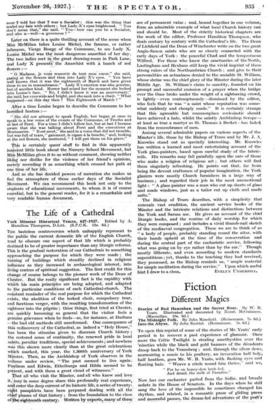The Life of a Cathedral
York Minster Historical Tricts, 627-1927. Edited by A. Hamilton Thompson, D.Litt. (S.P.C.K. 12s. 6d.) THE tasteless controversies which unhappily represent to the public the current domestic life of the English Church; tend to obscure one aspect of that life which is probably. destined to be of greater importance than any liturgic reforms. This is the gradual restoration of our Cathedrals to something approaching the purpose for which they were made ; the tattling of buildings which steadily declined in religioui influence as they increased in archaeological interest, into living centres of spiritual suggestion. The first credit for this change of course belongs to the pioneer work of the Dean of Cheater: But the really significant fact is the rapidity with Which- his main. principles are being adopted, and adapted to the particular conditions of each Cathedral-church. The constant reminder of the real purpose for which the Cathedral exists, the abolition of the locked choir, compulsory tour, and facetious verger, with the resulting transformation of the sightseer into the pilgrim these things, first tried at Chester, are. quickly becoming so general that the visitor feels a genuine grievance when he finds—as, for instance, at Durham —the bad old methods still unreformed. One consequence of thii rediscovery of the Cathedral, as indeed a " Holy House," has been the stimulus given to diocesan Church history ; the restored sense of continuity, the renewed pride in local saints, peculiar traditions, special achievements ; and nowhere was this shown more clearly than at the great celebrations which marked, this year, the 1,300th anniversary of York Minster. Then, as the Archbishop of York observes in the volume under review, " The past seemed to live again. Paulinue and Edwin, Ethelburga and Hilda seemed to be preSent, and with them a great cloud of witnesses."
That all who visit the Minster, and all who know and love it, may in some degree share this profoundly real experience, and enter'the deep current of its historic life; a series of twenty- eight pamphlets have been prepared,. dealing with all the' chief phases of that history ; from the foundation to the close ofpse*Oteent4 century. - Written by cprperte,many of these
are of permanent value.; and,,bound together in one volume; -tbrm an admirable example of what local Church history can and should be. Most of the strictly historical chapters are the work of the editor, Professor Hamilton Thompson, who deals century by century with the Cathedral's life. The Dean of Lichfield and the Dean of Winchester write on the two great Anglo-Saxon saints who are so closely connected with the early days of York : the peaceful Chad and the tempestuous Wilfred. For those who know the. sanctuaries of the North; Lastingham and Hexham still keep the vivid imprint of these strong rulers of the Northumbrian Church ; ,and give to their personalities an actualness denied to the amiable St. William; whose shrine was the chief glory of the Minster during the later Middle Age. St. William's claim to sanctity, founded on his prompt and successful emission of a prayer when the bridge over the Ouse broke under the weight of a sightseeing crowd, is lightly—even contemptuously—dismissed by the editor, who feels that he. was " a saint whose reputation was some- what suddenly and cheaply made." It is certainly strange that this agreeable but commonplace ecclesiastic should have achieved a halo, whilst the saintly Archbishop Scrope- at least as true a martyr as St. Thomas a Becket—has faded from the remembrance of men.
Arriong several admirable papers on various aspects of the Minster's life, those by the Bishop. of Truro and by Mr. J. A, Knowles stand out as specially interesting. Mr. Knowles has written a learned and most entertaining account of the York glass-painters, based upon careful study of the fabric- rolls. His remarks may fall painfully upon the ears of those who make a religion of religious art ;. but others will find them singularly refreshing. He points, out that, far from being the devout craftsmen of popular imagination, the York glaziers were mostly Church furnishers in a large . way of business ; and kegarded their job in the most unemotional light : " A glass painter was a man who cut up sheets of glass and made windows, just as a tailor cut up cloth and made suits."
The Bishop of Truro describes, with a simplicity that conceals vast erudition, the ancient service books of the Minster and the intricate relations and distinctions between the York and Sarum use. He gives an account of the chief liturgic books, and the routine of daily worship for which they were composed ; and includes a vivid thumb-nail sketch of the mediaeval congregation. These we are to think of as " a body of people, probably standing round the altar, with their hands upheld at the time of the consecration and during the central part of the eucharistic service, fallowing what was going on by eye rather than by the ear.'.' Though mostly illiterate, and even according to modern standards superstitious ; yet, thanks to the teaching they had received, they possessed, as the Bishop reminds us, " ample material for simple meditation during the service." Upon which useful






















































 Previous page
Previous page